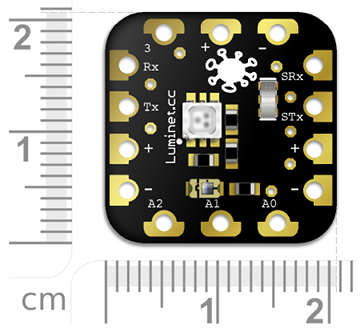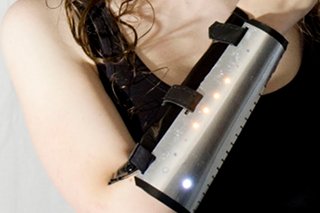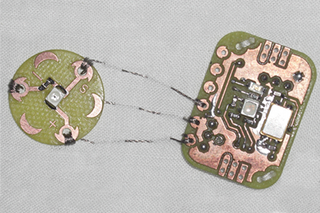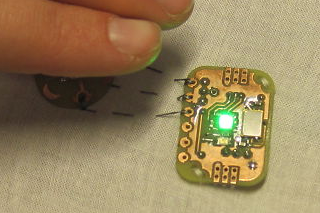LumiNet2: An Organic Interactive Illumination and Sensor Network for Fashion
 LumiNet2 is a smart pixel and more. It was developed by Mariana Bocoi as part of her Master's thesis, supervised by René Bohne, and based on Jan Borchers' original LumiNet node design.
LumiNet2 is a smart pixel and more. It was developed by Mariana Bocoi as part of her Master's thesis, supervised by René Bohne, and based on Jan Borchers' original LumiNet node design.
LumiNet2 uses the concept of Programming by Light as introduced by AnioMagic. To upload a program to a node, all you have to do is to hold the node up to your laptop screen, and run a web app. This way, the node does not need any additional programming interfaces, or to be removed from the cloth in order to change its behavior.
The nodes combine the Programming by Infection from the original LumiNet with the simplicity and ease of use of Programming by Light. That means you can inject the program into one node, and it will spread through ("infect") the entire network of connected nodes automatically.
Compared to the original LumiNet, LumiNet2 features some hardware design changes to make them easier to understand and use. Nodes are now connected in a 1-D chain topology rather than a 2D grid topology to simplify programming communication. Instead of an ATtiny85, they use an ATmega328 to be more powerful and fully Arduino-compatible.
LumiNet2 is smaller and lighter, which makes it easier to integrate them into clothes. All connectors are designed for easy sewing but also soldering of conductive ribbon.
MotivationProvide a framework for networks of smart nodes that can be extended to large scale, while keeping assembly and interaction easy to understand and use by professionals from other domains like fashion design. |
Goals
|
Download Thesis
You can download a PDF version of the thesis here.
Application: 8x8 matrix display
We developed a textile matrix display that uses 8x8 LumiNet2 nodes. The special fabric was created at RWTH Aachen University's ITA textile research institute. More details can be found in this wiki.
Types of Nodes
- Simple node: RGB LED and light sensor.
- Extended node: can have additional sensors or actuators attached.
Extended node design

Wearable computing frameworks: State of the art and related work
- LumiNet - The original organic illumination network LumiNet2 is based on
- LilyPad - as of this writing, one of the most widely used boards for wearable projects
- FLORA Adafruit's wearable electronics platform
- Seeeduino Film - Flexible board that can be integrated into wearables
- Sparkle - Wearable LED toolkit introducing Programming by Light
- Fabrick.It - collection of wearable electronic modules, or "bricks", that make it easy to build simple wearable projects
- BlinkM - small, I2C-controllable RGB LEDs that can be configured with a certain behavior and then integrated into clothes or the environment.
Other projects
Light sensitive arm guardDuring the first Smart Fashion Aachen workshop, Anna Witkopp created a light sensitive arm guard with one prototype LumiNet2 node, a light sensor and eight LEDs. Because of the small size of the LumiNet2 node, it was preferred over LilyPad boards or the original LumiNet nodes. She used both conductive thread and conductive fabric for the electrical connections. Each 2 LEDs use a dedicated LumiNet2 pin, so the arm guard can generate different blinking patterns.
Light sensor tutorialA LumiNet2 prototype node was used in the example for the light sensor tutorial with the Arduino software.
|





